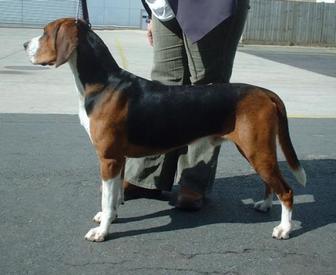
Otherwise known as the 'Hamilton Hound,' the breed was first developed in Sweden where it was bred from crossing between the German hounds and English Foxhound. Count Adolf Hamilton, the founder of the Swedish Kennel Club, developed the breed for the purpose of sole hunting fox and hare, without being dependent on a pack. The Hamiltonstovare falls within the 'hound' branch of canines, sharing its classification with the Bloodhound, Greyhound, Whippet and Beagle.
Athletically built, the breed boasts a slender and proportionate frame, muscular legs, a deep chest for enhanced lung capacity aiding stamina, a tapering muzzle and low-set, 'drop' ears. Common in colour variations of black, white and tan, the Hamiltonstovare is an attractive and distinctive dog with a non-shedding double coat that is easy to maintain. Characteristic to the breed is its tendency to hunt alone.
A typical hound in its temperament and behaviour, the breed retains its strong hunting instincts, often compelling it to round up and retrieve smaller animals. Such an instinct requires careful management from an early age, so consistent training and firm leadership within the home setting is encouraged. The Hamiltonstovare is a highly trainable breed, making it easy to house and obedience train, whilst being adaptable to the domestic environment. Compatible with children, the breed is suited to active families, providing its needs are met. The average Hamiltonstovare will weigh 22-27 kg, with a life expectancy of roughly 12 years when shown the appropriate care.
Bred for its inherent hardiness and endurance, the Hamiltonstovare is typically healthy and long-lived. No serious genetic or hereditary diseases have been identified in the breed, neither have breed-specific ailments. As with most breeds, incidences of skin allergy and hip dysplasia do occur, with epilepsy appearing rarely.
Do you own a Hamiltonstovare? Let others know what they're like!
Related products
Advantage 80 Spot On Flea Control Large Cats and Rabbits
from £12.95
Advantage 40 Spot On Flea Control Cats, Small Dogs and Rabbits
from £12.95
Advantage 100 Spot On Flea Control Medium Dog
from £12.95
Advantage 250 Spot On Flea Control Large Dog
from £12.95
Drontal Tasty Bone Wormer Tablets for Small & Medium Dogs (2 to 20kg)
from £2.15
FRONTLINE Plus Flea & Tick Treatment Dogs & Cats
from £17.49
TermaWorm™ Tablets for Cats & Dogs
from £1.59
Drontal Tasty Bone XL Wormer Tablets for Large Dogs (Over 20kg)
from £6.39